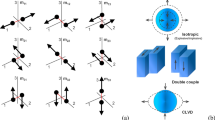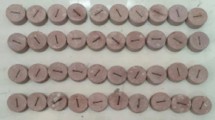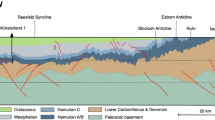Abstract
The deeply buried petroleum reservoirs are usually associated with fault zones resulting from substantial tectonic activities. Thus, the issue of wellbore stability is particularly important since these natural fractures are quite abundant in fault zones. In this study, we focus on the wellbore stability of a deeply buried petroleum well located in the Tarim area of China. The well was drilled into an Ordovician limestone formation with a buried depth of 8000 m. Laboratory tests were conducted on rock samples to characterize the mineral compositions, micro-structures, and strength properties. Dual-porosity theories of poromechanics were employed to derive stress and pore pressure distributions in the limestone formation surrounding the wellbore. The risk of wellbore instability was analyzed accordingly. Our results show that stress distribution is susceptible to borehole azimuth. In addition, effective stresses in the rock matrix and fractures surrounding the borehole were derived and analyzed separately, where two failure criteria were applied to rock matrix and fracture, respectively. Given the in situ stress conditions, the importance of selecting the optimum well trajectory is highlighted. Time-dependent solutions were used to show the importance of including fracture strength in stability analysis of wellbores drilled in fractured porous media.















Similar content being viewed by others
References
Abousleiman Y, Cui L (1998) Poroelastic solutions in transversely isotropic media for wellbore and cylinder and cylinder. Int J Solids Struct 35(34–35):4905–4929. https://doi.org/10.1016/S0020-7683(98)00101-2
Abousleiman Y, Ekbote S (2005) Solutions for the inclined borehole in a porothermoelastic transversely isotropic medium. J Appl Mech 72(1):102–114. https://doi.org/10.1115/1.1825433
Abousleiman Y, Nguyen V (2005) Poromechnanics response of inclined wellbore geometry in fractured porous media. J Eng Mech ASCE 131(11):1170–1183
Aifantis EC (1979) On the response of fissured rocks. Developments Mechanics 10:249–253
Akhtar S, Li B (2020) Numerical analysis of pipeline uplift resistance in frozen clay soil considering hybrid tensile-shear yield behaviors. International Journal of Geosynthetics and Ground Engineering 6:47. https://doi.org/10.1007/s40891-020-00228-9
Allen RF, Baldini NC, Donofrio PE, Gutman EL, Keefe E, Kramer JG, Leinweber CM, Mayer VA (1988) Annual book of ASTM standards. ASTM, West Conshohocken, PA
An M, Zhang F, Chen Z, Elsworth D, Zhang L (2020a) Temperature and Fluid Pressurization Effects on Frictional Stability of Shale Faults Reactivated by Hydraulic Fracturing in the Changning Block, Southwest China. J Geophys Res Solid Earth 125:e2020JB019584. https://doi.org/10.1029/2020JB019584
An M, Zhang F, Elsworth D, Xu Z, Chen Z, Zhang L (2020b) Friction of Longmaxi Shale Gouges and Implications for Seismicity During Hydraulic Fracturing. J Geophys Res Solid Earth 125:e2020JB019885. https://doi.org/10.1029/2020JB019885
Bradley WB (1979) Failure of inclined boreholes. J Energy Resour Technol 101(4):232–239. https://doi.org/10.1115/1.3446925
Dashti R, Rahimpour-Bonab H, Zeinali M (2018) Fracture and mechanical stratigraphy in naturally fractured carbonate reservoirs-A case study from Zagros region. Mar Pet Geol 97:466–479. https://doi.org/10.1016/j.marpetgeo.2018.06.027
Deng S, Li H, Zhang Z, Zhang J, Yang X (2019) Structural characterization of intracratonic strike-slip faults in the central Tarim Basin. AAPG Bull 103(1):109–137. https://doi.org/10.1306/06071817354
Ding W, Fan T, Yu B, Huang X, Liu C (2012) Ordovician carbonate reservoir fracture characteristics and fracture distribution forecasting in the Tazhong area of Tarim Basin, Northwest China. J Pet Sci Eng 86-87:62–70. https://doi.org/10.1016/j.petrol.2012.03.006
Ding Y, Liu X-J, Luo P-Y (2020) Investigation on influence of drilling unloading on wellbore stability in clay shale formation. Pet Sci 17(3):781–796. https://doi.org/10.1007/s12182-020-00438-w
Ezati M, Azizzadeh M, Riahi MA, Fattahpour V, Honarmand J (2020) Wellbore stability analysis using integrated geomechanical modeling: a case study from the Sarvak reservoir in one of the SW Iranian oil fields. Arab J Geosci 13(4):149. https://doi.org/10.1007/s12517-020-5126-1
Fang Y, Elsworth D, Ishibashi T, Zhang F (2018) Permeability Evolution and Frictional Stability of Fabricated Fractures With Specified Roughness. J. Geophys. Res. Solid Earth 123:9355–9375. https://doi.org/10.1029/2018JB016215
Fjaer E, Holt RM, Horsrud P, Raeen AM, Risnes R (1992) Petroleum Related Rock Mechanics. Elsevier, Amsterdam
Li C, Wang X, Li B, He D (2013) Paleozoic fault systems of the Tazhong Uplift, Tarim Basin, China. Mar Pet Geol 39(1):48–58. https://doi.org/10.1016/j.marpetgeo.2012.09.010
Li B, Wong RCK, Milnes T (2014) Anisotropy in capillary invasion and fluid flow through induced sandstone and shale fractures. Int J Rock Mech Min Sci 65:129–140. https://doi.org/10.1016/j.ijrmms.2013.10.004
Li B, Wong RCK, Xu B, Yang B (2018) Comprehensive stability analysis of an inclined wellbore embedded in Colorado shale formation for thermal recovery. Int J Rock Mech Min Sci 110:168–176. https://doi.org/10.1016/j.ijrmms.2018.07.019
Méndez JN, Jin Q, González M, Zhang X, Lobo C, Boateng CD, Zambrano M (2020) Fracture characterization and modeling of karsted carbonate reservoirs: A case study in Tahe oilfield, Tarim Basin (western China). Mar Pet Geol 112:104104. https://doi.org/10.1016/j.marpetgeo.2019.104104
Norouzi E, Moslemzadeh H, Mohammadi S (2019) Maximum entropy based finite element analysis of porous media. Front Struct Civ Eng 13:364–379. https://doi.org/10.1007/s11709-018-0470-x
Paterson MS, Wong T-F (2005) Experimental Rock Deformation - The Brittle Field. Springer-Verlag, Berlin Heidelberg
Puzrin AM (2012) Constitutive modelling in geomechanics. Springer, Berlin Heidelberg
Stehfest H (1970) Algorithm 368: numerical inversion of Laplace transforms. Commun ACM 13(1):47–49
Tian F, Luo X, Zhang W (2019) Integrated geological-geophysical characterizations of deeply buried fractured-vuggy carbonate reservoirs in Ordovician strata, Tarim Basin. Mar Pet Geol 99:292–309. https://doi.org/10.1016/j.marpetgeo.2018.10.028
Wilson RK, Aifantis EC (1982) On the theory of consolidation with double porosity. Int J Eng Sci 20(9):1009–1035. https://doi.org/10.1016/0020-7225(82)90036-2
Wu G, Xie E, Zhang Y, Qing H, Luo X, Sun C (2019a) Structural diagenesis in carbonate rocks as identified in fault damage zones in the northern Tarim basin, NW China. Minerals 9(6):360
Wu J, Fan T, Gomez-Rivas E, Gao Z, Yao S, Li W, Zhang C, Sun Q, Gu Y, Xiang M (2019b) Impact of pore structure and fractal characteristics on the sealing capacity of Ordovician carbonate cap rock in the Tarim Basin, China. Mar Pet Geol 102:557–579. https://doi.org/10.1016/j.marpetgeo.2019.01.014
Wu G, Zhao K, Qu H, Scarselli N, Zhang Y, Han J, Xu Y (2020) Permeability distribution and scaling in multi-stages carbonate damage zones: Insight from strike-slip fault zones in the Tarim Basin, NW China. Mar Pet Geol 114:104208. https://doi.org/10.1016/j.marpetgeo.2019.104208
Zeng W, Liu X, Liang L, Xiong J (2018) Analysis of influencing factors of wellbore stability in shale formations. Arab J Geosci 11(18):532. https://doi.org/10.1007/s12517-018-3865-z
Zhang Y, Tan F, Sun Y, Pan W, Wang Z, Yang H, Zhao J (2018) Differences between reservoirs in the intra-platform and platform margin reef-shoal complexes of the Upper Ordovician Lianglitag Formation in the Tazhong oil field, NW China, and corresponding exploration strategies. Mar Pet Geol 98:66–78. https://doi.org/10.1016/j.marpetgeo.2018.07.013
Zhang F, An M, Zhang L, Fang Y, Elsworth D (2020) Effect of mineralogy on friction-dilation relationships for simulated faults: Implications for permeability evolution in caprock faults. Geosci Front 11:439–450. https://doi.org/10.1016/j.gsf.2019.05.014
Acknowledgements
The authors would like to thank China Petroleum & Chemical Corporation for the support of this project. Financial support by Concordia University Seed start up grant (NO. VS1233) is acknowledged. Comments from three anonymous reviewers are very beneficial for this manuscript.
Author information
Authors and Affiliations
Corresponding author
Ethics declarations
Conflict of interest
The authors declare that they have no conflict of interest.
Additional information
Responsible Editor: Zeynal Abiddin Erguler
Highlights
• Laboratory tests on rocks retrieved from super deep petroleum well were conducted.
• Dual-porosity theory was applied to analyze wellbore stability.
• The importance of considering fracture strength in borehole stability analysis was highlighted.
Appendices
Appendix A
The solution of \( {\sigma}_{\mathrm{r}\mathrm{r}}^{(1)}-{\sigma}_{\mathrm{r}\mathrm{r}}^{(2)}-{\sigma}_{\mathrm{r}\mathrm{r}}^{(3)},{\sigma}_{\uptheta \uptheta}^{(1)}-{\sigma}_{\uptheta \uptheta}^{(2)}-{\sigma}_{\uptheta \uptheta}^{(3)},{\sigma}_{\mathrm{r}\theta}^{(3)},{\mathrm{P}}^{\mathrm{I}(2)},{\mathrm{P}}^{\mathrm{I}(3)},{\mathrm{P}}^{\mathrm{I}\mathrm{I}(2)} \) and PII(3) in the Laplace domain are given as (Abousleiman and Nguyen 2005):
Where s is the Laplace parameter, \( \left(\overline{\mathrm{P}}\right) \) denotes the Laplace transformation and Kn is the modified Bessel function of the second kind of nth order. For brevity, remaining expressions and coefficients are shown in
Appendix B
ξIand ξIIare two positive roots of the following characteristic equation
κr is mobility ratio which can be found by fluid mobility κ as
in which kI and kII are the permeability of matrix and fracture respectively.
M11, M12,M21 and M12, are lumped coefficients defined as
in which the material coefficients can be founded by
where
Rights and permissions
About this article
Cite this article
Heidari, S., Li, B., Zsaki, A.M. et al. Stability analysis of a super deep petroleum well drilled in strike-slip fault zones in the Tarim Basin, NW China. Arab J Geosci 14, 675 (2021). https://doi.org/10.1007/s12517-021-06709-z
Received:
Accepted:
Published:
DOI: https://doi.org/10.1007/s12517-021-06709-z




